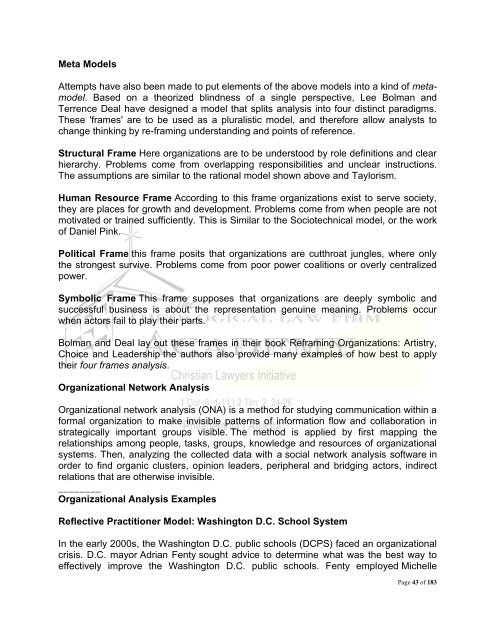The 508(c)(1)(a) Initiative Workshop
The 508(c)(1)(a) Initiative Workshop
The 508(c)(1)(a) Initiative Workshop
Create successful ePaper yourself
Turn your PDF publications into a flip-book with our unique Google optimized e-Paper software.
Meta Models<br />
Attempts have also been made to put elements of the above models into a kind of metamodel.<br />
Based on a theorized blindness of a single perspective, Lee Bolman and<br />
Terrence Deal have designed a model that splits analysis into four distinct paradigms.<br />
<strong>The</strong>se 'frames' are to be used as a pluralistic model, and therefore allow analysts to<br />
change thinking by re-framing understanding and points of reference.<br />
Structural Frame Here organizations are to be understood by role definitions and clear<br />
hierarchy. Problems come from overlapping responsibilities and unclear instructions.<br />
<strong>The</strong> assumptions are similar to the rational model shown above and Taylorism.<br />
Human Resource Frame According to this frame organizations exist to serve society,<br />
they are places for growth and development. Problems come from when people are not<br />
motivated or trained sufficiently. This is Similar to the Sociotechnical model, or the work<br />
of Daniel Pink.<br />
Political Frame this frame posits that organizations are cutthroat jungles, where only<br />
the strongest survive. Problems come from poor power coalitions or overly centralized<br />
power.<br />
Symbolic Frame This frame supposes that organizations are deeply symbolic and<br />
successful business is about the representation genuine meaning. Problems occur<br />
when actors fail to play their parts.<br />
Bolman and Deal lay out these frames in their book Reframing Organizations: Artistry,<br />
Choice and Leadership the authors also provide many examples of how best to apply<br />
their four frames analysis.<br />
Organizational Network Analysis<br />
Organizational network analysis (ONA) is a method for studying communication within a<br />
formal organization to make invisible patterns of information flow and collaboration in<br />
strategically important groups visible. <strong>The</strong> method is applied by first mapping the<br />
relationships among people, tasks, groups, knowledge and resources of organizational<br />
systems. <strong>The</strong>n, analyzing the collected data with a social network analysis software in<br />
order to find organic clusters, opinion leaders, peripheral and bridging actors, indirect<br />
relations that are otherwise invisible.<br />
________<br />
Organizational Analysis Examples<br />
Reflective Practitioner Model: Washington D.C. School System<br />
In the early 2000s, the Washington D.C. public schools (DCPS) faced an organizational<br />
crisis. D.C. mayor Adrian Fenty sought advice to determine what was the best way to<br />
effectively improve the Washington D.C. public schools. Fenty employed Michelle<br />
Page 43 of 183
















